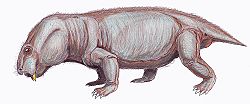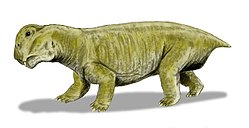| Kannemeyeria Temporal range: Anisian ~ | |
|---|---|
 | |
| Skull of Kannemeyeria simocephalus | |
| Scientific classification | |
| Kingdom: | Animalia |
| Phylum: | Chordata |
| Clade: | Synapsida |
| Clade: | Therapsida |
| Clade: | † Anomodontia |
| Clade: | † Dicynodontia |
| Family: | † Kannemeyeriidae |
| Genus: | † Kannemeyeria Seeley, 1908 |
| Type species | |
| †Kannemeyeria proboscoides Seeley, 1908 (Junior synonym of K. simocephalus) | |
| Species | |
| |
| Synonyms | |
Genus synonymy
Species synonymy
| |
Kannemeyeria is a genus of dicynodont that lived during the Anisian age of Middle Triassic period in what is now Africa and South America. [1] The generic name is given in honor of Daniel Rossouw Kannemeyer, the South African fossil collector who discovered the original specimen. [2] It is one of the first representatives of the family, and hence one of the first large herbivores of the Triassic.








